Piper excelsum
ENCYCLOPEDIA BOTANICA / KAWAKAWA
This beautiful New Zealand native is a popular local aromatic plant, and is used widely in both modern and traditional practices. Kawakawa is a member of the Piperaceae family (which includes black pepper and kava) and the entire family share a spicy and numbing peppery taste. All parts of kawakawa can be utilised in some way, and all have slightly different flavour profiles.
Description & Habitat
Kawakawa (Piper excelsum) can be found growing in the understory of coastal and lowland New Zealand forests. It is a small, shrubby tree that prefers the edges of the forests rather than the dense heart of the understory. Kawakawa has a branching habit with many stems that are smooth and jointed like bamboo, but slightly more knobbly and uneven.
The beautiful heart-shaped leaves are a dark, glossy green with rib-like veins fanning out from the point where the leaf grows from the stem—like rays from the sun. The leaves have a shiny, waxy coating.
The upright flower spikes appear like candles on a Christmas tree—looking gloriously decorative. The flowers often grow as pairs, with male and female flowers growing on separate plants. They are without stalks and made up of tightly interlocking scales. Once the flowers are pollinated, they turn a golden yellow and sometimes fuse together. The contrast of the deep green heart-shaped leaves and the golden, upright candles is striking.


The plant bears a strong resemblance to its close cousin kava (Piper methysticum), a powerful sedative that is esteemed throughout the Pacific, and the Māori word ‘kawakawa’ is a modification of the original ‘kavakava’. Māori are thought to have brought kava with them when they arrived in New Zealand, but found it was too cold for this sacred plant to survive outside of its traditional tropical Pacific island habitat.
The word kawa means 'bitter', and also ‘protocol’ indicating the plant’s cultural significance (kawa or tikanga). It is a taonga (highly prized) plant for Māori including as a luck charm for women trying to get pregnant, at naming ceremonies, and for removing tapu (sacred, spiritual restriction) during the opening of a new meeting house, launching a new canoe or as a symbol of mourning.
The meaning of its scientific name Piper excelsum breaks down as— ‘piper’ from Indian for pepper, and ‘excelsum’ meaning tall, as it stands out amongst the other low-growing vines and bushes of the Piperaceae family.
Significance to Māori: Used in ceremony and ritual and as one of the most important rongoā rākau (medicinal plants) is traditionally used to treat many ailments from digestive and urinary issues, skin complaints and the numbing quality is useful for dental complaints.
The leaves that are laced with holes are chosen for medicine as they are viewed as more potent. This may well be the case—as triggered by the attacks of the looper moth caterpillar (Cleora scriptaria) the leaves will produce more VOCs (and are likely to be of more interest to aromaticists as well).
Parts used: Leaves, buds/flowers, fruit and roots—both fresh and dried.
When harvesting the leaves do not be put off by the holey latticed ones that have been attacked by the looper moth caterpillar—they are fine to use and often they are the most peppery. Leaves (like all parts) can be used fresh or dry. To dry, lay the leaves on a mesh surface so there is plenty of air movement, and they should dry to a dark olive-green colour.
The buds can be harvested separately and dried. You can also lightly toast them—this enhances the pepperiness, adds a nutty flavour, and an oily mouthfeel.


Aroma & Flavour Profile
All parts of kawakawa can be utilised, and all parts have slightly different flavour profiles. The particular flavour profile of each part will also vary depending on the stage of the plant’s growing cycle and environmental issues (this is true for every plant).
The leaf: This is one of the most-used parts, since it is very versatile and easy to harvest without harming the plant. Take a leaf and crush and smell it (we recommend multiple short, strong sniffs—the warmth and moisture emitted from that action kick starts our body’s response to the VOCs encountered). A kawakawa leaf has a fresh, herbal green note with an underlying spice finish similar to nutmeg. This is because myristicin is one of the bioactive molecules in both these plants. Myristicin is known for its anti-inflammatory, antimicrobial properties and as an insecticide it helps prevent damage from most insects (except the looper caterpillar that has adapted to thrive on it).
The leaf texture is chewy, and it takes a while for our saliva to break down the waxy coating. The taste is bitter, but not unpleasantly so—it causes saliva to start flowing into the mouth followed by that peppery, spicy flavour—all the while with a green, herbal character. There’s a slight tingling sensation on the tongue and numbing—although it’s not as intense as echinacea. The similarity to nutmeg becomes more apparent the longer your saliva has been working in the leaf.
It’s a similar experience when tasting the buds and flowers. The buds tend to be more peppery and less herbal and the ripe buds and flowers are sweet-peppery with little herbal character.
The fruit are ready to eat when they’ve turned orange, and the flavour is like tropical fruit (some say paw-paw, some rock melon, some banana/citrus) with a peppery finish—though some avoid this by not chewing into the seeds when they eat the fruit.

Recommended techniques
• Hydro distillation (hydrosol) • Combo hydro/steam distillation (hydrosol/EO) • Infused oils • Simple infusions (teas) • Tincure • Spirit distillation (gin/aromatic spirits/liqueurs) • Culinary •
Uses
Infused oil
Kawakawa produces very little essential oil, but both dried and fresh kawakawa make a great infused oil. Those non-polar compounds (compounds that are not attracted to water) will come over into the oil—it will take on a stunning dark green character and have the herbal aroma of the leaves. The infused oil can be used in balms, and the oil phase of emulsions or creams.
Essential oil
Kawakawa isn't well-known for it's EO, as it is quite hard to come by (the yield being very low). We usually come across the essential oil as a by-product distilling large volumes for hydrosol in a combo hydro/steam distillation. As it takes such large volumes of plant material to produce even a small amount, it's not really viable to distil for EO, and instead we enjoy it as a bonus of our hydro distillations. If you are lucky enough to get a measurable amount of EO, you'll find it sinks to the bottom of the collection vessel, as it is one of the few EOs that are denser than water. Other EOs that display this trait are vetiver, wintergreen, clove and cinnamon. The aroma is similar to the hydrosol but it has a deeper spice character nothing overwhelming. We found it stimulating, sparky and uplifting (releasing a few of those joy chemicals, like eating chocolate).
Teas and tisanes
Both fresh and dried leaves can be used in infusions, and kawakawa tea is now widely commercially available. It is very easy to make yourself—simply bruise two or three fresh leaves, pour over the hot water and leave to infuse. This tea is fresh and zingy with that characteristic green-herbal-pepper flavour—good on its own or is often mixed with other ingredients like honey and ginger. The tea is a diuretic, and Māori used kawakawa infusions to treat a wide variety of ailments. European settlers experimented with brewing native plants into teas and were a fan of both kawakawa and manuka tea, while others have used the leaves in brewing.
Culinary
Kawakawa has an array of culinary uses. The dried leaves can be powdered up and used like pepper, and the ripe buds are good to use in salads and as a garnish for drinks. Robert Vennell describes many uses for kawakawa in his brilliant book The Meaning of Trees, outlining how Māori use it as a relish, cook with it in hāngī and serve it with meat and fish,as well as detailing many new and inventive uses. We recommend you give it a read.
Hydrosol
Kawakawa hydrosol is one of our favourites at The Alembics Lab, and we put it to many uses. The hydrosol is opaque and creamy on first coming out of the still, and clears over several days. As kawakawa often does not produce a measurable amount of EO on distillation, but you may see a few drops of the EO collecting on the surface of your hydrosol in a large distillation. It then floats to the bottom (yes, it sinks) and then most times it will become re-integrated with the water. The opaqueness comes from these heavier and less polar compounds that take longer to become fully integrated with the hydrosol. The fact that it clears over several days indicated the continued changes in the chemistry of the solution. It's aroma and flavour profile is vegetative but fresh, green and peppery. Kawakawa hydrosol can be used in skin care formulations, tonics, zero ABV spirits and botanical cocktails.
Spirits
There are stories that Captain Cook made beer from Kawakawa leaves with some success and it helped cure scurvy amongst the crew. It’s a popular addition to some NZ spirits—mostly gin. The dried and toasted buds add a herbal peppery note and a dry finish, and add to the mouthfeel of a spirit. As mentioned earlier, it’s also a great addition to a bitters recipe.
Tinctures
Tincturing Kawakawa leaves in 40% alcohol will draw out the dark green of the chlorophyll and an array of both polar and nonpolar compounds. This could be used as part of a bitters blend to add a peppery, spicy, herbal heat, to add colour to cocktails and as phytomedicine.
GCMS reports
Here is a link to a list to a GCMS table (from Laboratoire Phytochemia) of the main constituents of a typical kawakawa hydrosol. This analysis shows you which compounds are present after a hydro-distillation. *It's important to note that different methods of extraction will yield different levels of compounds in their respective GCMS analyses. Some compounds are water-soluble, so will be present in higher levels in hydrosol, while some are not and will be present at higher levels in oils.
References & Resources
Māori healing and herbal : New Zealand ethnobotanical sourcebook. M Riley and B Enting. Published by Viking Sevenseas N.Z (1994).
Check out our courses



